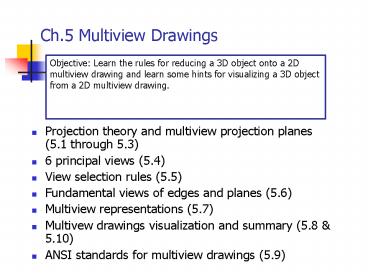Ch.5 Multiview Drawings - PowerPoint PPT Presentation
1 / 18
Title:
Ch.5 Multiview Drawings
Description:
... and the object is oriented such that only two of its dimensions ... The best method to learn the art of multiview representation of 3D objects is to ... – PowerPoint PPT presentation
Number of Views:59
Avg rating:3.0/5.0
Title: Ch.5 Multiview Drawings
1
Ch.5 Multiview Drawings
Objective Learn the rules for reducing a 3D
object onto a 2D multiview drawing and learn some
hints for visualizing a 3D object from a 2D
multiview drawing.
- Projection theory and multiview projection planes
(5.1 through 5.3) - 6 principal views (5.4)
- View selection rules (5.5)
- Fundamental views of edges and planes (5.6)
- Multiview representations (5.7)
- Multivew drawings visualization and summary (5.8
5.10) - ANSI standards for multiview drawings (5.9)
2
Multiview Projection (5.1 through 5.3)
- See Fig. 5.1 to locate the multiview projections
in the taxonomy of projects Projection ?
Parallel projections ? Orthographic projections ?
Multiview projections.
Object
Projection plane
Line of sight
3
Multiview Projection
- Multiview projection is an orthographic
projection for which the object is behind the
plane of projection, and the object is oriented
such that only two of its dimensions are shown.
4
6 principal views (5.4)
Open up the glass box, producing the 6 principal
views.
5
US (ANSI 3rd-angle projection) vs. ISO (1st-angle
projection)
6
Steps to create a 3-view multiview drawing
7
View selection (5.5)
- Determine the best position of the object. Try
to make the surfaces of major features either
perpendicular or parallel to the projection
planes. - Define the front view. The front view should
show the object in its natural or assembled
state. - Determine the minimum number of views is needed
to completely describe the object so it can be
produced. - Once the front view is selected, determine which
other views will have the fewest number of hidden
lines.
8
View selection (cont.)
Bad orientation
Good orientation
9
Fundamental views of planes (5.6)
Normal plane
Oblique plane
Inclinedplane
10
Fundamental views of edges
Oblique line
Normal line (true-length line)
Inclined line
11
Normal, inclined, or oblique?
12
Multiview representations (5.7)
- Many examples of multiview representations are
given in this chapter. The best method to learn
the art of multiview representation of 3D objects
is to draw by yourself, with tools or freehand,
the objects shown in Figures 5.47 through 5.68.
We do not have time to cover all that are
presented in the chapter. I present here only
those that require a bit of explanations.
13
Multiview representations (5.7)
14
Multiview drawings visualization (5.8 5.10)
- Practice makes perfect. Without it, you will
never learn this art of visualizing 3D objects
from 2D multiview drawings. - Projection studies
- Physical model construction
- Adjacent labeling
- Missing lines
- Vertex labeling
- Analysis of solids
- Analysis of surfaces
15
Multiview drawings visualization (5.8 5.10),
cont.
16
ANSI Standards for multiview drawings (5.9)
- Partial view
17
ANSI Standards for multiview drawings (5.9)
- Revolution
Too busy
18
ANSI Standards for multiview drawings (5.9)
- Revolution
- Removed view
Make the drawings easy to understand!































